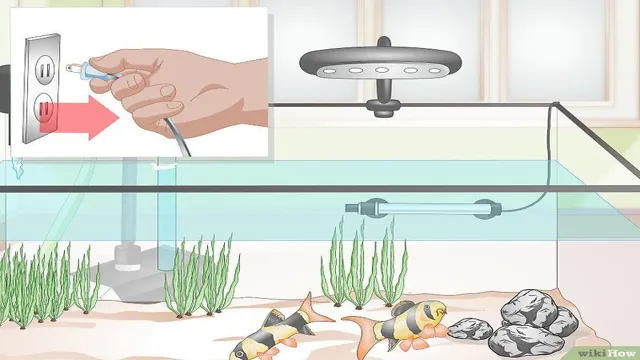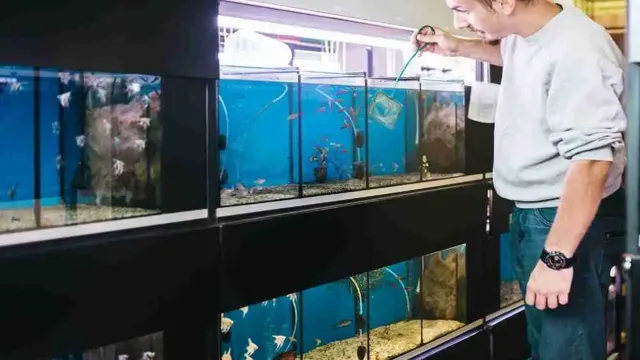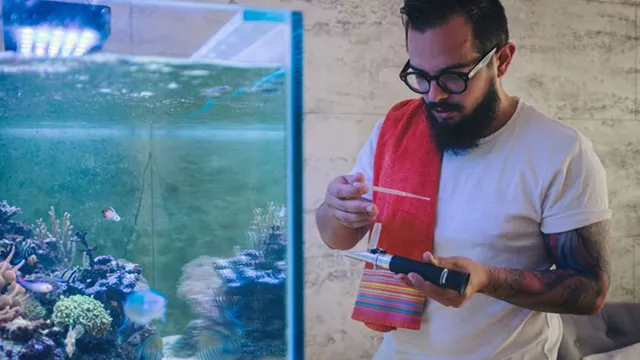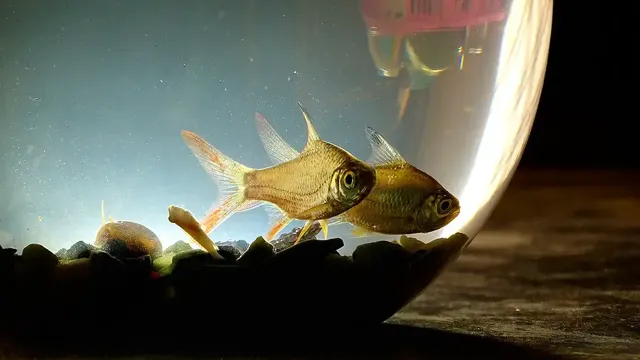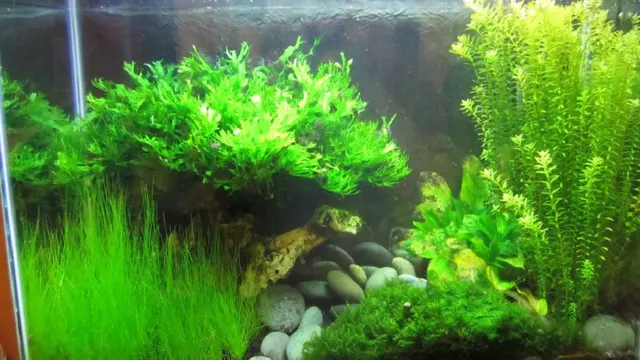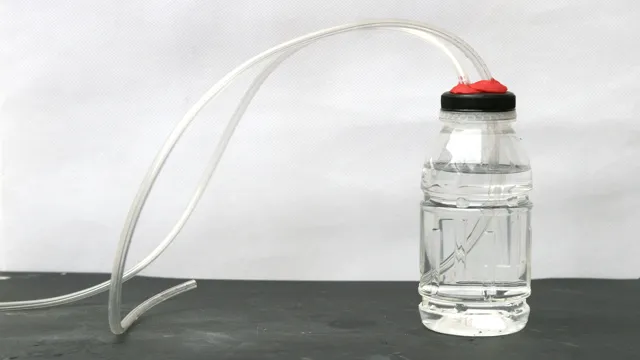Keeping your aquarium clean and healthy is essential for the well-being of your aquatic pets. One of the critical tasks is changing the water regularly. As simple as it sounds, many aquarium owners dread this chore, considering it cumbersome and time-consuming.
However, it doesn’t have to be a daunting task. With the right tools and techniques, you can make water changes a breeze. In this post, we’ll show you the easiest way to change water in your aquarium and keep your fish in the best possible conditions.
Gathering Supplies
When it comes to performing an easy water change on your aquarium, the first step is to gather all the necessary supplies. You’ll need a siphon hose, a bucket, a scrub brush, and your chosen water conditioner. Make sure to double-check the instructions on the water conditioner so that you add the correct amount.
A siphon hose is the perfect tool for easy water changes because it helps you to remove the right amount of water while preventing any unwanted debris from being sucked into the hose. Using a bucket that you only use for aquarium water changes is important because it prevents the transfer of any harmful chemicals or bacteria. A scrub brush helps to clean off any buildup on the walls of the aquarium, allowing you to maintain a healthy environment for your aquatic friends.
Remember, having the right supplies is key to an easy and successful water change!
Get a siphon
One essential tool that every beginner should have when starting their own aquarium is a siphon. This simple device is used to clean the gravel at the bottom of your tank and remove any debris or waste that has accumulated. Without a siphon, it can be challenging to keep your aquarium clean, and you risk bacterial overgrowth, which can be harmful to your fish and other aquatic life.
When choosing a siphon, look for one that is easy to use and provides enough suction to access all areas of the tank. With a little practice, using a siphon will become a quick and straightforward task that will help ensure a healthy and enjoyable environment for your underwater pets. So, remember, before starting your aquarium, be sure to get a siphon – your fish will thank you for it!
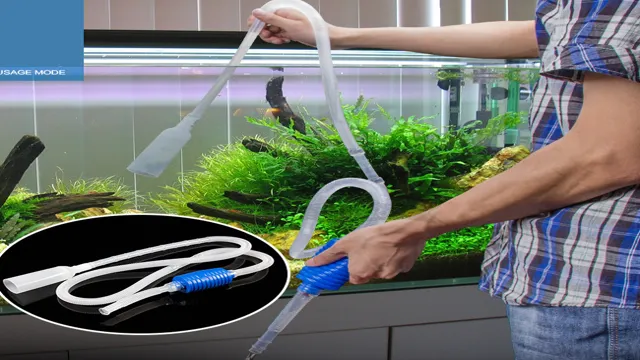
Get a bucket
One essential supply for any household emergency is a bucket. While it may seem like a basic item, a bucket can serve multiple purposes during a crisis. It can be used to collect water from a nearby source or store water for future use.
Additionally, a bucket can be used to collect rainwater for drinking or cleaning purposes. It can also serve as a portable toilet or waste disposal option when indoor plumbing is unavailable. Don’t underestimate the usefulness of a bucket, it can be a lifesaver in a difficult situation.
Make sure you have one (or several) readily available in your emergency supplies kit.
Preparing the Aquarium for Water Change
If you want to do the easiest water change on your aquarium, you need to prepare the aquarium first. This means that you should turn off all equipment, including the filter, heater, and lights. Next, you should gather all the necessary tools and materials, such as a siphon hose for removing the water, a bucket for collecting the old water, and a water conditioner for treating the new water.
Once you have all the materials, you can start removing the old water from the tank using the siphon hose. It’s important to avoid disturbing the gravel or decorations too much while doing this to prevent any harmful particles from getting into the water. After removing around 25-30% of the water, refill the tank with fresh, treated water at the same temperature as the old water.
Once the water level is at the desired level, you can turn all the equipment back on and enjoy your sparkling clean aquarium. By following these simple steps, you can do a water change on your aquarium with ease and ensure the health and happiness of your aquatic pets. (See Also: How to Coax Fish to Explore New Spaces in Your Aquarium: Tips and Tricks)
Turn off all equipment
If you’re planning to do a water change for your aquarium, it’s important to prepare the tank properly. One of the first steps you should take is turning off all equipment. This includes filters, heaters, and air pumps.
This is because when you start adding water to the tank, it can cause fluctuations in temperature and flow which can be harmful to your aquatic pets. By turning off all equipment beforehand, you’ll reduce the risk of any sudden changes and give your fish time to acclimate to the new water conditions. So, take a few minutes to turn everything off and ensure that your aquarium is ready for a successful water change.
Remember, a little preparation can go a long way in ensuring the health and safety of your aquatic pets.
Remove debris from the water surface
When it comes to preparing the aquarium for a water change, one important step is to remove any debris from the water surface. This can include anything from uneaten food to leaves or other plant matter. Not only does debris on the surface look unsightly, but it can also cause problems with the water quality and potentially harm the fish in the tank.
Using a net or skimmer, carefully remove any floating debris from the surface of the water before beginning the water change process. By taking this simple step, you can help ensure that your aquarium stays clean and healthy for all its inhabitants. So, take the time to scoop out the debris before you start changing the water, and your fish will thank you for it!
Removing Water from the Aquarium
If you’re looking for the easiest way to remove water from your aquarium, look no further than a siphon hose. This simple piece of equipment allows you to easily suck water out of the tank and into a bucket for disposal. To use a siphon hose, first, fill the hose with water by submerging it in the aquarium and sucking on the other end until water starts flowing.
Once the water is flowing, lower the end of the hose into a bucket and let gravity do the rest. It’s important to monitor the water level in the tank to ensure you don’t remove too much water at once, as this can disrupt the balance of the aquarium. With a siphon hose, you can quickly and easily change the water in your aquarium without getting your hands wet.
Siphon out the water
Removing Water from the Aquarium can be a difficult task, but it is essential for maintaining the health of your aquatic pets. One effective method is to siphon out the water using a gravel vacuum. This tool allows you to remove debris and waste from the bottom of the aquarium while also draining the water.
Simply submerge the vacuum in the tank and start the suction process. As the water level drops, move the vacuum around the tank to ensure that all areas are cleaned. Once the desired amount of water has been removed, simply turn off the suction and dispose of the dirty water.
Repeat this process as often as needed to ensure a clean and healthy living environment for your fish. Remember to use caution when removing the water, as sudden changes in temperature or pH levels can be harmful to your aquatic pets. With a little bit of effort and patience, you can easily maintain a thriving aquarium.
Siphon out the waste and debris on the gravel
When it comes to maintaining a healthy and clean aquarium, removing water from the tank is a crucial step. But rather than just dumping the water out, it’s important to siphon out the waste and debris that can accumulate in the gravel at the bottom of the tank. This is where a good gravel vacuum comes in handy. (See Also: How to Clean Rubber Aquarium Decorations Easily and Effectively)
By creating a siphon with the vacuum, you can easily remove the dirty water and waste from the bottom of the tank without disturbing your fish or plants. It’s important to be gentle and not to remove too much water at once, especially if you have sensitive fish or plants in the tank. But by regularly siphoning out the waste and debris, you’ll be helping to maintain a healthy and thriving environment for all of your aquatic inhabitants.
Adding Fresh Water to the Aquarium
When it comes to aquarium maintenance, one of the most important tasks you’ll need to undertake is the water change. Freshwater needs to be added regularly to ensure your aquatic pets can thrive in a healthy environment. But fear not, as it’s easy to do the easiest water change on an aquarium.
Firstly, you’ll want to prepare your fresh water. This means using a water conditioner to remove any chlorine or other harmful chemicals, and also ensuring that the water is the same temperature as the water currently in the aquarium. Then, using a siphon or hose, remove roughly 20-30% of the existing water in the tank and then slowly add the fresh water.
It’s important to not add too much water too quickly, as this can shock your pets and cause unnecessary stress. Repeat this process once every two to four weeks, depending on the size of your aquarium and number of inhabitants. Consistency is key to successfully maintaining a beautiful and healthy aquarium.
Prepare and add fresh water
Adding fresh water to your aquarium is crucial for maintaining a healthy aquatic environment. Before adding the water, it’s important to prepare it properly. First, be sure to remove chlorine and other harmful chemicals by using a dechlorinator or letting the water sit for at least 24 hours.
You’ll also want to make sure the temperature of the new water matches that of the aquarium to prevent shocking your fish. When adding water, pour it in slowly to avoid disturbing the substrate and any decorations. It’s recommended to change out 10-20% of the water in your aquarium every 1-2 weeks to keep it fresh and free of waste buildup.
By maintaining proper water quality, your fish will thrive and you’ll enjoy a beautiful and healthy aquatic environment.
Add dechlorinator if necessary
Adding Freshwater to Your Aquarium: Don’t Forget to Add Dechlorinator if Needed When adding fresh water to your aquarium, it is important to remember that tap water often contains chlorine and other harmful chemicals that can harm your delicate fish. That’s why it’s essential to use a dechlorinator when adding new water to your tank. Dechlorinators remove harmful chemicals from tap water, making it safe for your fish.
Before you add any water to your tank, it’s a good idea to test it for chlorine levels. If your tap water does contain chlorine, you’ll need to use a dechlorinator before adding it to your aquarium. Simply follow the instructions on the dechlorinator bottle, and add the specified amount to your tap water.
Keep in mind that not all tap water contains chlorine, so testing is the best way to know for sure. It’s always better to be safe than sorry, so adding a dechlorinator is a good habit to get into even if you’re not sure whether or not your water contains chlorine. Remember, adding fresh water to your aquarium is crucial for maintaining water quality and keeping your fish healthy.
But be sure to use a dechlorinator if necessary to ensure the safety of your aquatic pets.
Conclusion
In conclusion, performing a water change on your aquarium doesn’t have to be a daunting task. With the right tools and a bit of knowledge, you can breeze through this routine maintenance task with ease. Just remember to turn off your equipment, test your water parameters beforehand, use a reliable siphon, and don’t forget to treat the water before adding it back into your tank. (See Also: How to Do a Complete Water Change in an Aquarium – Step by Step Guide)
Your fish will thank you for it, and your aquarium will thrive with clean water. So, go ahead, take a deep breath, and dive into the world of aquarium maintenance. It’s not as hard as it seems!”
FAQs
What equipment do I need to do a water change on my aquarium?
You will need a siphon hose, a bucket, and a water conditioner.
How often should I do a water change on my aquarium?
The frequency of your water changes may vary depending on the size of your aquarium and the number of fish you have, but a general rule is to change 10-20% of the water every 1-2 weeks.
Do I need to remove my fish during a water change?
It’s not necessary to remove your fish during a water change, but it’s important to be gentle and make sure they don’t get sucked up by the siphon hose.
Can I add tap water directly to my aquarium?
No, tap water contains chlorine and other harmful chemicals that can harm your fish. Always use a water conditioner to remove these chemicals before adding water to your tank.
What if I have plants in my aquarium?
If you have live plants in your aquarium, you may need to adjust the frequency and amount of your water changes. Consult with a professional or do research on the specific plants you have.
Is it necessary to vacuum the gravel during a water change?
Yes, vacuuming the gravel during a water change will help remove any excess waste and debris that can build up over time.
How do I know if I’m doing the water change correctly?
You should see a noticeable improvement in the clarity and quality of your aquarium water after a water change. If you have any concerns or questions, consult with a professional or do further research.

